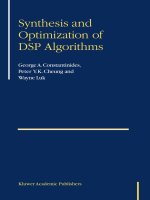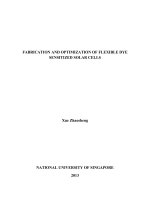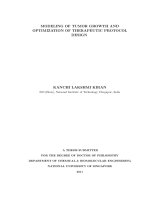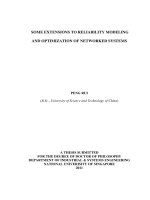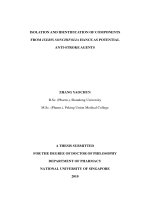Isolation and optimization of the growth conditions of thermophilic microorganism from hot springs
Bạn đang xem bản rút gọn của tài liệu. Xem và tải ngay bản đầy đủ của tài liệu tại đây (323.75 KB, 6 trang )
55
Nong Lam University, Ho Chi Minh City
Isolation and optimization of the growth conditions of thermophilic microorganism
from hot springs
Kha M. Tran1 , Van T. T. Le1 , Duy D. Ngo2 ,
Khanh Q. Hoang2 , Phong V. Nguyen3 , & Tri H. Nguyen1∗
1
Department of Biology, Nong Lam University, Ho Chi Minh City, Vietnam
2
Institute of Tropical Biology, Ho Chi Minh City, Vietnam
3
Department of Biotechnology, Nong Lam University, Ho Chi Minh City, Vietnam
ARTICLE INFO
ABSTRACT
Research paper
The aim of this study was to isolate and optimize the growth
conditions of thermophilic microorganism from hot springs. The
isolation was conducted by using the mineral salt basal medium
supplemented with 0.6% yeast extract at 500 C. Totally, 33 isolates
of thermophilic microorganism were isolated from hot springs at
Truong Xuan (Khanh Hoa province) and Binh Chau (Ba Ria Vung Tau province). The effects of temperature (45 - 800 C), pH
(pH 6 - 9) and carbon sources (malate, pyruvate, acetate, glucose,
fructose, or carbon dioxide) on the growth of isolates were examined. In addition, the isolate morphology was also investigated
by Gram and spore staining. The isolated thermophilic microorganism showed the diversity in colony morphology and color appearance. Most of them were rod shaped, spore-forming and most
grew well at 500 C and pH 7. The highest growth of all isolates
was observed under malate, glucose, or fructose, as an organic carbon source and unable to use carbon dioxide. Six out of 33 thermophilic microorganism isolates (namely BM7, BS5, NS1, NS3,
NS4, and NW6) grew rapidly under high temperatures from 50 550 C and their morphology characteristics showed high similarity
to Bacillus sp. The study evidenced the polymorphic diversity of
thermophiles in the geothermal hot spring ecosystems.
Received: April 24, 2018
Revised: May 30
Accepted: June 17, 2018
Keywords
Bacillus spp.
Hot spring
Isolation
Spore staining
Thermophilic microorganism
∗
Corresponding author
Nguyen Huu Tri
Email:
Cited as: Tran, K. M., Le, V. T. T, Ngo, D. D., Hoang, K., Nguyen, P. V., & Nguyen, T. H.
(2018). Isolation and optimization of the growth conditions of thermophilic microorganism from
hot springs. The Journal of Agriculture and Development 17(3), 55-60.
1. Introduction
Hot springs, the emerged water bodies produced by geo-thermally heated groundwater, are
scattered all over the globe, in every continent
and even under the sea. In Vietnam, there are
more than 287 hot springs and water containing dissolved minerals distributed in different regions of the country (Cao et al., 1998). There
are many previous studies that focus on investigation about geological features of geothermal
areas (Rastogi et al., 2010; Tran et al., 2012; Tulasi et al., 2013). Besides, the geothermal ecosys-
www.jad.hcmuaf.edu.vn
tems such as hot springs and volcanic eruption areas are the habitat of thermophilic microorganisms. Based on the range of optimal
growth temperature, thermophiles are classified
into the following groups: moderate thermophiles
(40-600 C), extreme thermophiles (60-850 C) and
hyperthermophiles (>850 C) (Tulasi et al., 2013).
These thermophilic-derivative products could be
applied in biotechnology as industrially valuable
compounds. Extremophiles have provided an interesting and challenging platform for researchers
since they were explorered. Besides growth under
the extreme conditions, extremophiles could pro-
The Journal of Agriculture and Development 17(3)
56
duce thermophilic enzymes, biogradable plastic,
biofuel, etc. (Tulasi et al., 2013). Thermophilic
microorganisms capable of biosynthesis of heatresistant enzymes are widely used in the industry
where production conditions require high temperatures (Gaughran et al., 1947). During the past
few years, the interest in diversity, ecology, and
physiology and biochemistry of thermophiles has
increased rapidly in Vietnam. The thermophilic
bacterium species Geobacillus caldoxylosilyticus
was isolated from sedimental sludge of My Lam
hot spring in Tuyen Quang province, Vietnam
(Tran et al., 2012). Furthermore, this strain became promising candidate in industry due to
its capability of producing thermostable enzymes
such as cellulase and amylase (Tran et al., 2012).
The southern of Vietnam is very rich in hot
springs. One is Truong Xuan hot spring (M’ Dung
village, Ninh Hoa, Khanh Hoa), and another is
Binh Chau hot spring (Binh Chau commune,
Xuyen Moc district, Ba Ria – Vung Tau) that is
very famous in Vietnam. The diversity of microbial communities in these hot springs has not yet
been fully studied. This study aimed to isolate,
optimize, and evaluate the carbon utilization of
thermophilic microorganism isolated from these
locations. Results from this study were a preliminary step to apply thermophilic microorganism
and their products in biotechnology.
2. Materials and Methods
Soil, muddy, and water samples were collected at Truong Xuan hot spring (120 31’20”N,
1080 59’00”E, Ninh Hoa, Khanh Hoa), and Binh
Chau hot spring (100 36’21”N, 1070 33’29”E,
Xuyen Moc, Vung Tau). Hot water in Truong
Xuan hot spring was bubbled from the vein in
the rock with temperature ranging from 370 C to
670 C. The pH was recorded in the range of 7.78.0 indicating alkaline environment. Binh Chau
hot spring is the largest hot spring (more than
1 km2 ) in Vietnam. Water temperature in the
veins ranged from 430 C to 650 C with many bubbles, and smell hydrogen sulfide (H2 S). The pH
was recorded in the range of 7.8-9.2 indicating alkaline environment. The temperature of the sampling site is unstable, normally, the temperature
at the sampling sites was lower than that at the
veins.
Nong Lam University, Ho Chi Minh City
containers (Hildur et al., 2011). They were immediately brought into the laboratory and analyzed
within 24 hours. In total, 24 samples were collected from Truong Xuan (14 samples) and Binh
Chau (10 samples) hot springs. The samples (soil,
muddy, and water) were collected separately in
the vacuum flask, transported to laboratory and
analyzed within 24 hours.
The mineral salt basic (MSB) medium used for
microorganism growth and trace element solution
with the components are shown in Table 1 and
Table 2 (Goto et al., 1977). The isolation medium
was MSB supplemented with 0.6% yeast (w/v)
so-called as MSBY medium, pH 7.
Table 1. The components of basic
cultivation medium
Deionized Water
(NH4 )2 SO4
KH2 PO4
MgSO4 .7H2 O
K2 HPO4
NaCl
FeSO4 .7H2 O
CaCl2
Trace elements solution
Final pH
1.0 L
2.0 g
1.0 g
0.5 g
2.0 g
0.5 g
0.0011 g
0.03 g
0.5 mL
7.0
Table 2. The components of
trace elements solution
Deionized Water
MoO3
ZnSO4 .7H2 O
CuSO4 .5H2 O
H3 BO3
MnSO4 .5H2 O
CoCl2 .6H2 O
1.0 L
0.004 g
0.028 g
0.002 g
0.004 g
0.004 g
0.004 g
2.1. Isolation of thermophilic microorganisms
from hot springs
The thermophilic microorganisms were isolated
based on the possible growth at 500 C. Fifty Celsius degree was chosen to make the initial isolation temperature to isolate those microorganisms
that were capable of growing by 500 C or more.
The procedure of enrichment was as follows:
1 gram of soil, sludge or 1 mL of water was diSamples were randomly collected from differluted in 5 mL of MSB supplemented with 6 g/L
ent sites of off flow and stored in 500 mL sterile
of yeast extract and incubated at 500 C for 48
The Journal of Agriculture and Development 17(3)
www.jad.hcmuaf.edu.vn
57
Nong Lam University, Ho Chi Minh City
hours. The growth of microorganisms was observed and recorded via estimation of the environmental opacity in test tubes. A five tenfold
serial dilution was performed, and then spread
on MSBA plates (MSB medium supplemented
with agar 3% (w/w) and incubated at 500 C for
72 hours. Single colonies growing on plates were
transferred into freshly prepared MSBA slants
and kept at -200 C for further study. The isolates
were investigated by observation of colony morphology, Gram stain, and sporulation (Goto et
al., 1977).
3. Results and Discussion
2.2. Optimization of the growth condition of
the isolated thermophilic microorganisms
The colonies were appeared in various of color
(beige, white, yellow, or pink) including 7 isolates
were beige-colored, 11 were white, 14 were yellow,
and 1 was pink on MSBA medium (Figure 1).
3.1. Isolation of the thermophilic microorganisms from hot springs
Thirty three isolates that could grow at 500 C
were isolated from 24 soil, muddy, and water
samples from two hot springs in Khanh Hoa (16
isolates) and Ba Ria – Vung Tau (17 isolates)
provinces. Of 33 isolates, 11 isolates were obtained from soil (33.3%), 8 isolates from muddy
(24.3%) and 14 isolates from water (42.4%) samples (Table 3).
In order to determine the optimal temperature
for the growth of isolated thermophilic microorganisms, each isolate was inoculated in 5 mL of
MSBY medium (pH 7) in a test tube in range of
temperature from 450 C to 800 C, shaken at 180
rpm for 12 hours. Then, the optimum pH value
was examined between 6 and 9 at the optimal
temperature. The pH value was adjusted by using
1M NaOH solution. The microorganism growth
was determined at 3-hour intervals by measuring
the optical density (OD) of the cultures at 540 nm
and streaked onto freshly prepared MSBA plate
(Goto et al., 1977). The high thermo-tolerance Figure 1. Diversity of colonial morphology of isolates
microorganism from hot springs on MSBA.
isolates were selected for further experiments.
2.3. Investigation of the potential use of different carbon sources of the isolated thermophilic microorganism
The Gram-positive isolates were 18 isolates /33
(54.5%) of the collection. Of the 33 isolates, 31
(94%) were rod-shaped, with the size of cells in
range of 0.16 – 0.8 ± m, 20 isolates (60.6%) were
The carbon sources were used in this study able to form oval endospores and had the size of
including organic substrates [acetate (C2 ), pyru- the spores in range of 0.10 – 0.41 ± m (Figure
vate (C3 ), malate (C4 ), glucose (C6 ), or fructose 2). This result showed the diversity of the ther(C6 )] and inorganic substrate (CO2 ). The concen- mophilic microorganism communities in geothertration of carbon in the organic compounds was mal area.
equivalent to 15 mM. In order to evaluate the
use of CO2 , the isolates were cultured in MSB
medium with the addition of H2 : O2 : CO2 (80%:
10%: 10%) (Goto et al., 1977).
The cultures were incubated in a reciprocating
shaker at the optimal temperature and pH. The
initial OD value at 540 nm was 0.04-0.06. The
microorganism growth in various carbon sources
was recorded within 72 hours. The mean value
OD540 of triplicates for each experiment was an- Figure 2. Spore shapes of the isolates under microalyzed by using Microsoft Excel 2013 software.
scope observation (magnificent 1000X).
A: BS2; B: NW7; C: NW6; D: BM5; E: BS5;
F: BM5; G: BS4; H: BM8.
www.jad.hcmuaf.edu.vn
The Journal of Agriculture and Development 17(3)
58
Nong Lam University, Ho Chi Minh City
Table 3. Thermophilic microorganism isolated from hot springs
Hot spring
Binh Chau (B)
(Ba Ria – Vung Tau)
Truong Xuan (N)
(Nha Trang, Khanh Hoa)
Sample
Water (W)
Soil (S)
Mud (M)
Water (W)
Soil (S)
Mud (M)
Total
3.2. Optimization growth conditions of thermophilic isolates
In order to optimize the temperature and pH
for microorganism growth, the isolates were cultivated at temperature range from 450 C to 800 C
and pH range from 6 to 9. The result was shown
in details in Table 4. The aim of this study was to
isolate the microbes that were capable of growing
from 500 C, therefore the intended study temperature range was 45, 50, 55, 60, 65, 70, 75, 800 C.
However, at the temperature higher than 550 C
the growth of microorganisms isolated was very
weak. So, we focused on testing from 50 to 550 C.
At pH 9, the growth of microorganisms could not
be observed, then the data were not shown in Table 4.
After 12 hours of incubation, the OD540 values of six isolates including BM7 (0.73 ➧ 0.06,
at 500 C), BS5 (0.67➧0.02, at 520 C), NS1 (0.71
0
➧ 0.03, at 55oC), NS3 (1.04 ➧ 0.05, at 50 C),
0
NS4 (0.93 ➧ 0.04, at 50 C), and NW6 (0.82 ➧
0.09, at 550 C) were higher than the others. Of
these, isolates, BM7, NS3, NS4 grew optimal at
500 C with OD540 from 0.73 to 1.04, while growth
of isolate BS5 was optimal at 520 C with OD540
at 0.67 ➧ 0.02. Isolates NS1 and NW6 were optimal at 550 C with high OD540 at 0.71 ➧ 0.03
and 0.82 ➧ 0.09, respectively. The pH investigation also showed that isolate BS5 grew optimal
at pH 6, isolates BM7, NS1, NS3, NS4 grew optimal at pH 7 while NW6 was optimized at pH 8.
Moreover, the highest OD540 (1.18 ➧ 0.08) was
recorded in isolate NS3 at pH 7.
Isolate
3
6
8
11
5
0
33
Notation
BW1,2,3
BS 1,2,3,4,5,6
BM 1,2,3,4,5,6,7,8
NW1,2,3,4,5,6,7,8,9,10,11
NS1,2,3,4,5
cose, or fructose. Under CO2 condition, microorganism were grown in MSB medium (pH 7) with
a final gas phase consisting of H2 : O2 : CO2 (80%:
10%: 10%) at 500 C. However, none of isolate was
able to grow under autotroph condition. After
7 days of continuous observation, the turbidity
environmental change was not found in the test
tubes. This result suggested that there is no isolate could be fixed CO2 or grown autotrophically.
Experimental results showed that most isolates
developing favorably in the presence of malate,
glucose, or fructose. Malate acts as an intermediary helps the microbes produce energy as well as
metabolite to produce amino acids via the tricarboxylic acid cycle, whereas glucose or fructose is
easily metabolized via glycolysis pathway (Kim
et al., 2008). Hence, the isolates could favorably
utilize this organic substrate.
It is now very well-known that extreme thermophiles are mostly distributed among the genera of Bacillus, Clostridium, Thermoanaerobacter, Thermus, Thermotoga, Aquifex (Tulasi et al.,
2013). In which, Bacillus is a large and diverse
genus that is widely distributed in soil and thermal water areas (Claus & Berkeley, 1986). During
the past few decades, a great diversity of microorganisms has been discovered that exist in hot environments. In a previous report of Nguyen et
al. (2015), 64 aerobic isolates of thermophilic microorganism were identified from muddy and hot
water of Binh Chau hot spring. The percentage
of microorganism with cellulase, amylase and protease activities is 19%, 67% and 24% of total 64
microorganism isolates, respectively.
Cellular structure and enzyme activities are
deeply affected by temperature of habitat. For
any microbe to grow at high temperature, their
proteins must be able to resist heat. Hence, therOf the 33 isolates, 9 (27.3%) grew on acetate,
mophiles have accumulated various thermostable
15 (45.5%) grew on pyruvate and 24 (72.7%) were
enzymes that are high potential application in
able to use malate. All isolates were seen growth
biotechnology. The thermophilic strains of Bacilwell in MSB medium with the supplement of glu3.3. Evaluation of the use of different carbon
sources
The Journal of Agriculture and Development 17(3)
www.jad.hcmuaf.edu.vn
59
Nong Lam University, Ho Chi Minh City
Table 4. OD540 values of 33 isolates at different temperatures and pH
No.
Isolate
1
2
3
4
5
6
7
8
9
10
11
12
13
14
15
16
17
18
19
20
21
22
23
24
25
26
27
28
29
30
31
32
33
BM1
BM2
BM3
BM4
BM5
BM6
BM7
BM8
BS1
BS2
BS3
BS4
BS5
BS6
BW1
BW2
BW3
NS1
NS2
NS3
NS4
NS5
NW1
NW2
NW3
NW4
NW5
NW6
NW7
NW8
NW9
NW10
NW11
500 C
0.40 ➧ 0.03
0.59 ➧ 0.04
0.44 ➧ 0.01
0.36 ➧ 0.03
0.24 ➧ 0.02
0.40 ➧ 0.03
0.73 ➧ 0.06
0.45 ➧ 0.02
0.41 ➧ 0.05
0.43 ➧ 0.02
0.53 ➧ 0.03
0.35 ➧ 0.03
0.46 ➧ 0.07
0.35 ➧ 0.03
0.40 ➧ 0.01
0.42 ➧ 0.03
0.60 ➧ 0.03
0.45 ➧ 0.02
0.62 ➧ 0.03
1.04 ➧ 0.05
0.93 ➧ 0.04
0.43 ➧ 0.05
0.51 ➧ 0.01
0.26 ➧ 0.03
0.30 ➧ 0.04
0.55 ➧ 0.02
0.42 ➧ 0.02
0.68 ➧ 0.03
0.48 ➧ 0.02
0.42 ➧ 0.05
0.61 ➧ 0.02
0.60 ➧ 0.04
0.53 ➧ 0.05
Temperature
520 C
0.30 ➧ 0.02
0.33 ➧ 0.02
0.34 ➧ 0.03
0.45 ➧ 0.02
0.18 ➧ 0.04
0.22 ➧ 0.01
0.50 ➧ 0.02
0.42 ➧ 0.03
0.26 ➧ 0.02
0.10 ➧ 0.03
0.42 ➧ 0.07
0.27 ➧ 0.03
0.67 ➧ 0.02
0.43 ➧ 0.05
0.34 ➧ 0.02
0.38 ➧ 0.03
0.22 ➧ 0.01
0.59 ➧ 0.01
0.41 ➧ 0.03
0.52 ➧ 0.05
0.46 ➧ 0.01
0.34 ➧ 0.06
0.20 ➧ 0.02
0.03 ➧ 0.01
0.38 ➧ 0.02
0.03 ➧ 0.01
0.24 ➧ 0.02
0.46 ➧ 0.06
0.30 ➧ 0.04
0.12 ➧ 0.03
0.04 ➧ 0.01
0.16 ➧ 0.03
0.48 ➧ 0.04
550 C
0.23 ➧ 0.03
0.15 ➧ 0.01
0.29 ➧ 0.01
0.23 ➧ 0.02
0.14 ➧ 0.05
0.22 ➧ 0.07
0.47 ➧ 0.03
0.22 ➧ 0.04
0.25 ➧ 0.03
0.05 ➧ 0.02
0.34 ➧ 0.06
0.18 ➧ 0.03
0.30 ➧ 0.02
0.23 ➧ 0.03
0.24 ➧ 0.04
0.22 ➧ 0.06
0.29 ➧ 0.06
0.71 ➧ 0.03
0.23 ➧ 0.02
0.56 ➧ 0.03
0.30 ➧ 0.04
0.30 ➧ 0.03
0.36 ➧ 0.03
0.02 ➧ 0.01
0.23 ➧ 0.03
0.34 ➧ 0.05
0.22 ➧ 0.01
0.82 ➧ 0.09
0.06 ➧ 0.02
0.31 ➧ 0.05
0.51 ➧ 0.02
0.40 ➧ 0.03
0.35 ➧ 0.02
pH
7.0
6.0
0.10
0.16
0.25
0.02
0.26
0.15
0.54
0.02
0.14
0.23
0.15
0.17
0.71
0.14
0.50
0.18
0.11
0.32
0.34
0.83
0.92
0.50
0.14
0.04
0.23
0.19
0.15
0.48
0.16
0.26
0.12
0.13
0.19
➧
➧
➧
➧
➧
➧
➧
➧
➧
➧
➧
➧
➧
➧
➧
➧
➧
➧
➧
➧
➧
➧
➧
➧
➧
➧
➧
➧
➧
➧
➧
➧
➧
0.02
0.02
0.01
0.01
0.04
0.03
0.05
0.01
0.03
0.02
0.03
0.01
0.05
0.03
0.03
0.06
0.02
0.05
0.04
0.07
0.04
0.03
0.03
0.02
0.03
0.04
0.02
0.03
0.01
0.02
0.01
0.03
0.01
0.41
0.57
0.44
0.37
0.27
0.44
0.72
0.47
0.42
0.45
0.50
0.37
0.65
0.39
0.43
0.44
0.58
0.76
0.61
1.18
0.94
0.43
0.54
0.24
0.31
0.53
0.41
0.65
0.51
0.40
0.59
0.64
0.52
➧
➧
➧
➧
➧
➧
➧
➧
➧
➧
➧
➧
➧
➧
➧
➧
➧
➧
➧
➧
➧
➧
➧
➧
➧
➧
➧
➧
➧
➧
➧
➧
➧
8.0
0.04
0.06
0.02
0.03
0.02
0.04
0.04
0.03
0.02
0.03
0.03
0.01
0.06
0.02
0.03
0.02
0.05
0.03
0.05
0.08
0.10
0.01
0.03
0.01
0.03
0.06
0.05
0.06
0.04
0.01
0.03
0.04
0.05
0.09
0.08
0.19
0.06
0.24
0.13
0.57
0.12
0.16
0.27
0.13
0.10
0.52
0.31
0.30
0.08
0.17
0.40
0.08
0.73
0.57
0.13
0.11
0.05
0.14
0.12
0.07
0.98
0.09
0.14
0.06
0.05
0.22
➧
➧
➧
➧
➧
➧
➧
➧
➧
➧
➧
➧
➧
➧
➧
➧
➧
➧
➧
➧
➧
➧
➧
➧
➧
➧
➧
➧
➧
➧
➧
➧
➧
0.02
0.01
0.03
0.01
0.05
0.03
0.04
0.02
0.02
0.02
0.03
0.01
0.04
0.03
0.03
0.01
0.04
0.04
0.01
0.09
0.05
0.02
0.02
0.01
0.03
0.04
0.02
0.12
0.02
0.03
0.01
0.02
0.01
Table 5. Characteristics of six selected thermophilic microorganism isolates
Characteristic
Shape
Color
Gram/Spore
Optimum growth temperature (0 C)
Optimum growth pH
CO2
Acetate
Pyruvate
Malate
Glucose
Fructose
BM7
Rod
Cream
+/+
50
7
–
–
–
+
+
+
BS5
Rod
Yellow
+/+
52
6
–
–
–
+
+
+
NS1
Rod
Orange
+/+
55
7
–
–
–
+
+
+
NS3
Rod
Cream
+/+
50
7
–
–
–
+
+
+
NS4
Rod
White
+/+
50
7
–
–
–
+
+
+
NW6
Rod
White
+/+
55
8
–
–
–
+
+
+
+: positive; –: negative
www.jad.hcmuaf.edu.vn
The Journal of Agriculture and Development 17(3)
60
Nong Lam University, Ho Chi Minh City
lus that synthesized cellulase, amylase and pro- thank our colleagues from Institute of Tropitease have a great significance for many fields of cal Biology (Vietnam Academic of Sciences and
industry (Rastogi et al., 2010).
Technology), who provided insight and expertise
that greatly assisted the research.
References
Cao, T. D., Do, T. H., Nguyen, K. N., Chau, V. Q., &
Vu, N. T. (1998). Geographic Atlas of Vietnamese. Ha
Noi, Vietnam: Education Publishing House.
Claus, D., & Berkeley, R. C. W. (1986). The genus Bacillus. In Sneath, P. H. A. (Ed.). Bergey’s manual of
systematic bacteriology (1105-1139). Baltimore, USA:
Williams and Wilkins.
Figure 3. Image profiles of six selected thermophilic
microorganism isolates.
Table 5 and Figure 3 described the profile of
six selected thermophilic microorganism isolates
that were selected from thermophilic microorganism collection in this study in details. In order to
explore the potential application of six selected
thermophilic microorganism isolates, the identification of microorganism to species as well as enzyme activity screening is required. Recently, the
most effective approach to microorganism taxonomy may be analysis of 16S rDNA molecules by
oligonucleotide sequencing. Detailed information
of the molecular identification for six selected microorganism isolates will be announced very soon
elsewhere.
4. Conclusions
From the sources of samples collected form
the geothermal areas, we have successfully constructed the collection of thermophilic microorganism including of 33 isolates that are evaluated
in terms of morphology, microscopy, and growth
test on different substrates. Six selected isolates were Gram-positive, rod-shaped, and sporeforming. These characteristics of six selected isolates with the optimum growth temperature from
50-550 C were found highly similar to Bacillus
species. The achievement in collection of thermophiles is the preliminary step in effort to be
able to apply the thermophilic microbes into the
biotechnology sector.
Gaughran, E. R. (1947). The thermophilic microor ganisms. Bacteriological reviews 11(3), 189.
Goto, E., Kodama, T., & Minoda, Y. (1977). Isolation
and culture conditions of thermophilic hydrogen bacteria. Agricultural and Biological Chemistry 41(4), 685690.
Hildur V., Dagn´
y B. R., & J´
ohann O. (2011). Hydrogenophilus islandicus sp. nov., a thermophilic
hydrogen-oxidizing bacterium isolated from an Icelandic hot spring. International Journal of Systematic
and Evolutionary Microbiology 61, 290-294.
Kim, B. H., & Gadd, G. M. (2008). Bacterial physiology and metabolism. Cambridge, England: Cambridge
University Press.
Nguyen, T. K., Tran, T. T., Tran, H. T., & Tran M. D.
(2015). Potential of thermostable enzymes production
from bacterial strains isolated in Binh Chau hot spring.
The 6th Scientific Conference on Biological Resources.
Ha Noi, Vietnam.
Rastogi, G., Bhalla, A., Adhikari, A., Bischoff, K. M.,
Hughes, S. R., Christopher, L. P., & Sani, R. K. (2010).
Characterization of thermostable cellulases produced
by Bacillus and Geobacillus strains. Bioresource Technology 101(22), 8798-8806.
Tran, M. D., Nguyen, T. K., Nguyen, D. T., & Nguyen, V.
Q. (2012). Biological characteristics and classification
of the thermophilic bacteria BML07 strain producing
both thermostable amylase and cellulase isolated from
My Lam hot spring. Journal of Science and Technology 50(1), 29-38.
Tulasi, S., Jennifer, L., & Yutaka, K. (2013). Thermophilic Microbes in Environmental and Industrial
Biotechnology. In Biotechnology of Thermophiles (2th
ed.). New York, USA: Springer.
Acknowledgements
We appreciate Nong Lam University – Ho Chi
Minh City for the financial support under Research Project Code. CS-CB16-KH-03. We also
The Journal of Agriculture and Development 17(3)
www.jad.hcmuaf.edu.vn
